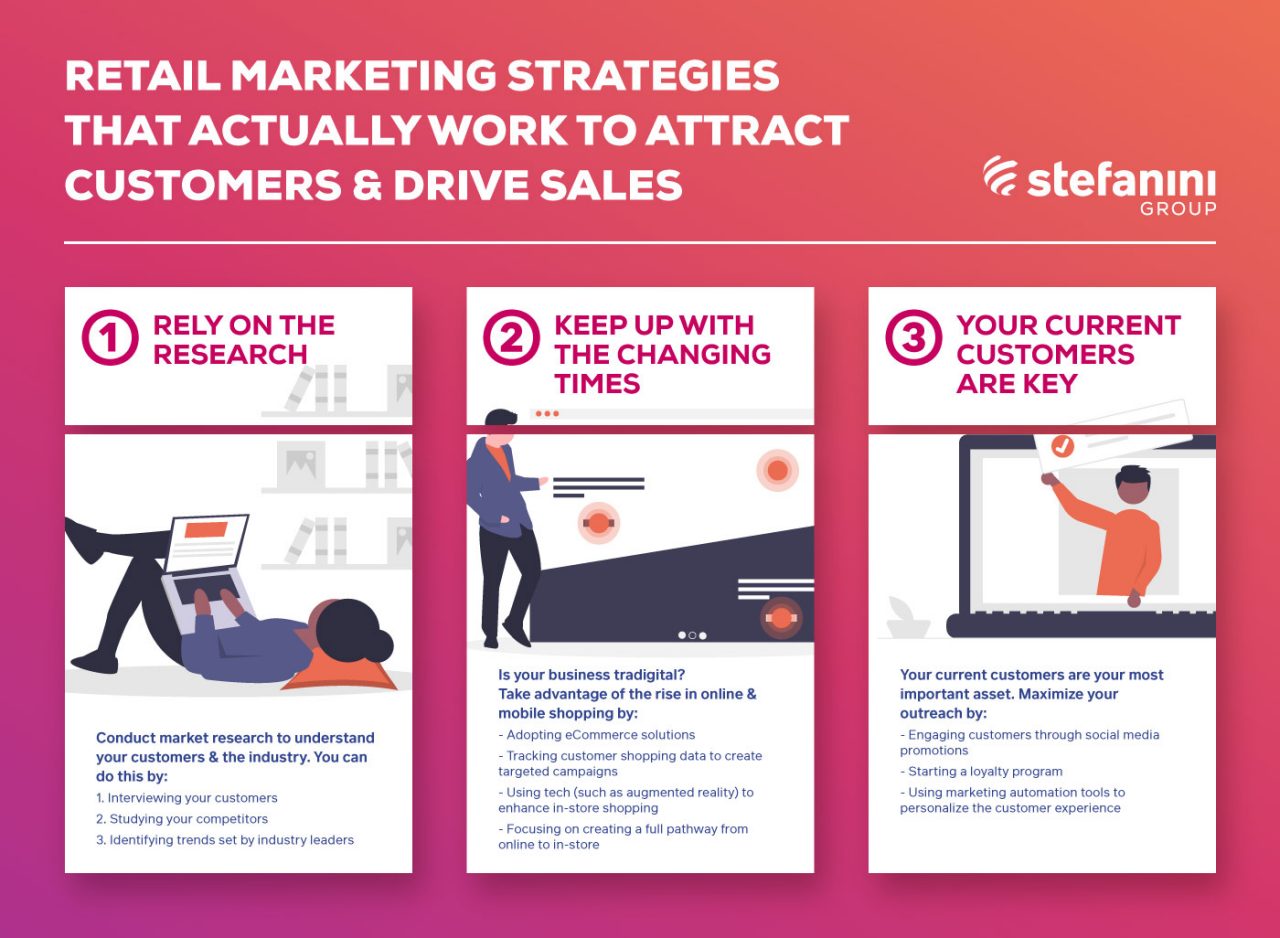Small business marketing isn’t as daunting a term as it seems. In fact, the most impactful marketing methods are also some of the easiest. Now that the pandemic has receded somewhat, new market trends have emerged.
Luckily, customers are stating what drives them to find a business and what makes them buy a product. With that in mind, here are three powerful marketing strategies for any business owner.
How can you use marketing technology to optimize your strategy? Learn more here!
Rely on the Research
Market research is essential to understanding your customers and the industry, both of which are great sources of information. Businesses can conduct the research themselves, thus saving money while creating a personalized outreach. The best first step is often asking customers; after all, they’re the ones making the purchases.

Phone and mailed surveys were once reliable sources of research data. These days, you’ll be lucky to hear back from 5% of consumers. Instead, stay trendy and incorporate personalized emails, texts, and even receipts. Create online surveys and use your CMS to create personalized outreach messages.
Have some specific goals in mind when conducting market research. If you’re going to your customers directly, seek to find out the following:
- Which of your competitors do they use?
- What do they like and dislike about your product?
- What industry products and services do they wish existed?
- How and when do they like to shop? What time of day, month, or year? Does it depend on budgeting conditions or sales specials?
Be sure to include any questions about your business. As well, always provide some kind of survey reward. For instance, link to a percentage-off coupon, or include store cash or credit. Tailor it to your business and its products. Let the customers know upfront there is a reward for providing information. This will help ensure a response.
A business owner can also study the industry for plenty of data. Look at competitors and industry leaders: what trends are they creating or following? And, how do those trends influence the entire industry?
When MailChimp simplified its designs, entire industries took note. Now, eCommerce stores and many online presences have adopted simplistic styles. For businesses, the reasons are evident. A clunky web experience will detract from browsing and shopping. Keeping the eye adhered to the products is easier when the site guides the eye.
Industry leaders will have paid the money and done the research. So, follow their lead to stay on top of explicit and intangible industry trends. Additionally, fine-tune your marketing by talking with your customers.
Which digital marketing trends should you know for 2022? Get the list here!
Keep Up With the Changing Times
If you’re still considering a website for your company, you’re well behind the times. Today’s customers demand convenience and a digital presence, and there are several new businesses stepping in to supply those needs. For continued success, businesses must therefore keep up with the changing industries.
Omnichannel marketing has arisen to ensure a business can keep up as the industry grows. The term omnichannel refers to offering customers the ability to make a purchase anywhere, including from online, mobile, and brick-and-mortar stores. Also known as “tradigital”, it highlights the growing trend of online and mobile shopping. Specifically, businesses should start:
- Adopting eCommerce solutions for their businesses
- Tracking customer shopping data to create targeted campaigns
- Using tech (such as augmented reality) to enhance in-store shopping
- Focusing on creating a full pathway from online to in-store
The goal of a tradigital business is to integrate all shopping options into one. Over half of all purchases are researched online before the sale. That means half of all purchases start online. Many customers will be willing to take that knowledge and go into a store; several others will turn to an online option. Omnichannel ensures your business can fulfill any type of customer.
BOPIS systems are a great example of the growing omnichannel trend. BOPIS (or buy online/pick up in-store) systems focus on convenience. During the height of the pandemic, retailers turned to BOPIS systems to stay operational. BOPIS and curbside pickup kept sales moving, and created a new level of expected customer convenience.
These days, BOPIS systems allow customers to buy an in-store inventory online. This allows for same-day “shipping” since the inventory is already at the store. It is this double serving of convenience that drives BOPIS systems. Almost half of all shoppers bought something because of the store’s BOPIS system, and often because of the quick and free shipping.
In this instance, the omnichannel system captures the customer online. It then allows them to catch a ride to the store as they make a one-click purchase on their smartphone. When they arrive at the store, they might also make some impulse purchases while waiting for their order. They then pick up, leave, and post a stellar review on social media.
No matter where they are, your customers should be able to do three things: communicate with the brand, browse the goods, and buy the products.
Your Current Customers Are Key
Customers and markets are changing; they are growing younger and more educated. As well, after the pandemic, catered convenience has become the norm. Fortunately, these facts only serve to highlight one major piece of information:
Your current customers are your most important asset.
It can cost 5 times more to get a new customer than to keep an existing one. Plus, your existing customers are more likely to buy your products. They are also already some of your greatest marketing tools. Through proper usage of social media, your own customers can grow your brand for you. While it might seem easy to stay connected on social media, though, there are other ways to maximize your outreach.
Marketing automation tools work as digital assistants; their jobs are to handle the day-to-day marketing. These tools allow one to schedule repeated tasks.
For example, create an email survey campaign a week in advance. When the campaign is live, it will trigger corresponding social media announcements. When customers respond to the email, they are automatically given a 15% store credit. And, with the sale completed, they get a text with an extra 10% off if they tag the business on social media.
Thus, by setting specific parameters, a business can hone its outreach.
However, where marketing automation really shines is how it personalizes the customer experience. Customized emails and texts can deliver personalized sales based on shopping habits. Or, you can collect direct-source data by including surveys on personalized receipts.
Marketing automation can also be tied into customer loyalty programs. Loyalty programs help strengthen customer relationships, and they are prime sources of customer retention. In fact, 71% of Americans stay with a brand because of its loyalty program.
Some powerful loyalty programs feature:
- Points programs to reward frequent buyers
- Subscription rewards for those making regular purchases
- App-based games to provide deals, sales, or even free items
- Free perks, such as gift cards or store coupons
Loyalty programs are perfect methods to gain valuable customer data, and they make perfect companions for marketing automation tools. Business owners can analyze and put this data to use.
Track eCommerce navigation and see what items customers are leaving in their carts. Send sales emails to coincide with the times that customers are prone to shop. Then, scan social media for trending topics and mentions.
Small business marketing isn’t as complicated as it seems, especially if you focus on the tech that makes it easy. Let automation tools and social media drive your market research. Get to know what your customers want, and personalize their experiences to their desires. Staying loyal to your customers will drive up their loyalty to your business. Ultimately, that will grow your market share.
About the author: Jessica Larson is a “serial entrepreneur” focused on finding the right balance between family life and business endeavors. Learn more at her website, SolopreneurJournal.com


















